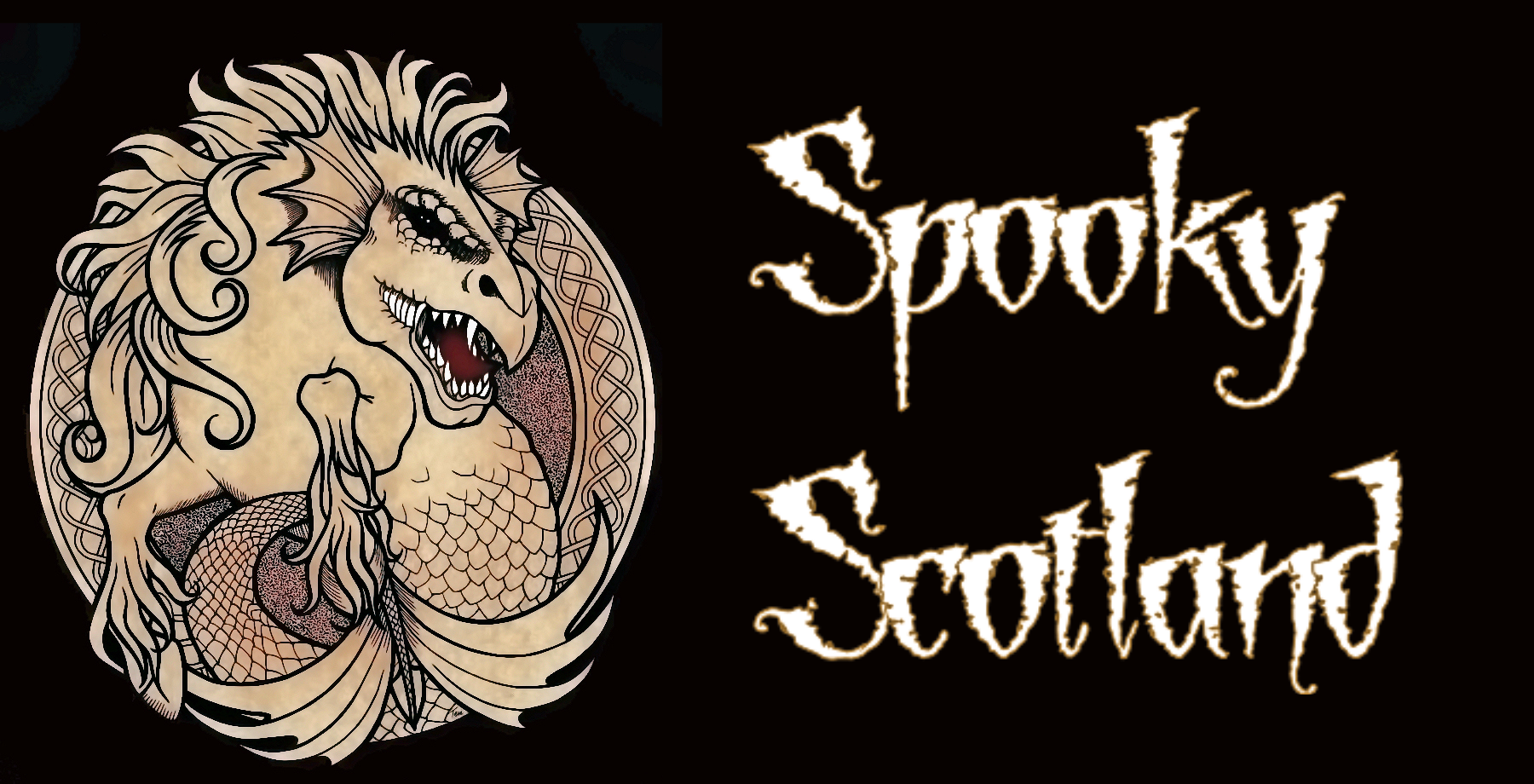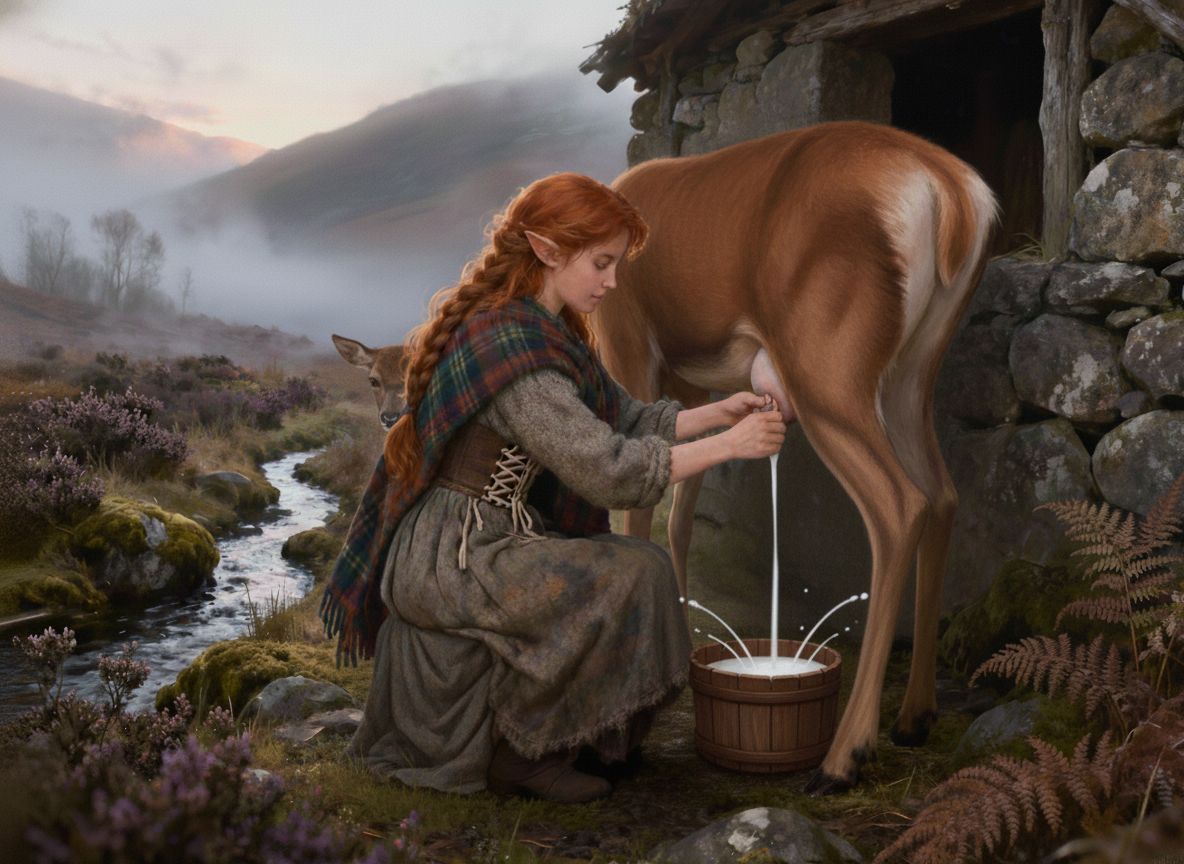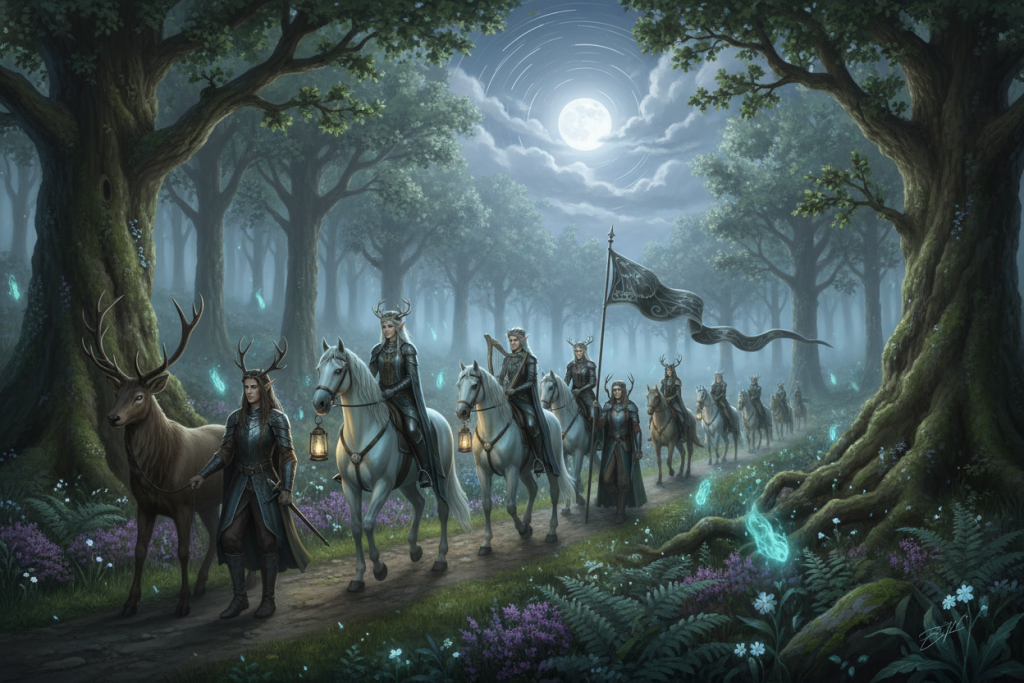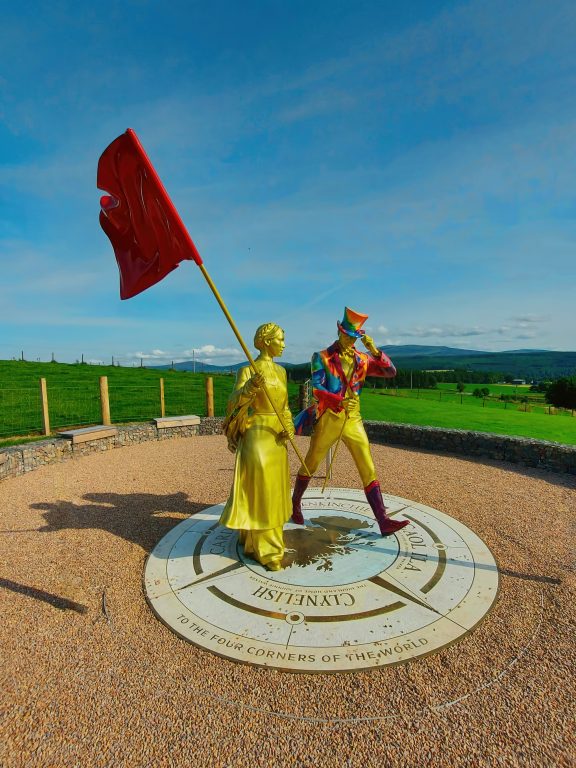Faery experiences come in many forms. Perhaps the most unique and intriguing example centres on Am Bratach Sith, the Fairy Flag of Dunvegan. To the uneducated eye, the disintegrating cloth in Dunvegan Castle looks more like a rag than the most precious heirloom of Clan MacLeod. Look closer at the silk, though, and remnants of an intricate pattern that feels both ancient and foreign become visible.
But on Skye, history and myth are interlaced, and belief in the sithichean runs back to prehistoric times. For as long as the clan has existed, so has its flag. Legend tells that at the dawn of time, a MacLeod chieftain met and fell in love with a beautiful maiden. Alas, she was a faery princess. She begged her father to let her wed the chief, and he consented on one condition. She must return to her folk at the end of a year and a day.
They married, and a son was born. But the year passed all too soon. Before returning beneath the hills, the princess made her husband swear that their young son must never be allowed to cry. Through his tears, the chief agreed.
A Faery Visit
Grief overcame him. To distract their lord, the retainers held a great feast. The sounds of revelry drew the baby’s nursemaid from the nursery for a stolen peek, and the child, awakened and alone, began to cry. When she returned, she found a woman bending over the cradle, comforting the child and wrapping him in a shawl. She gasped as the woman looked up—it was the child’s mother. And then she vanished into the night.
Years later, the boy spoke of that night and of the magic of the shawl: the MacLeods could use it three times in true danger and help would come, but on a fourth attempt the flag would disappear. Being a canny Scot, the chief took this seriously and had a casket made to guard the fairy flag.
Centuries passed. When the MacDonalds burned the church at Trumpan, a small band of MacLeods gathered on the shore. They unfurled the flag and, miraculously, their number seemed tenfold. The MacDonalds were routed, and the flag returned to its kist. Later, when plague decimated their cattle and starvation loomed, they waved it again, and the fairy host restored the herd to health.
One unfurling remains. Until then, the Fairy Flag rests behind glass in its room. Yet sometimes, from behind the pane, beautiful, ethereal music is heard—though there is nothing there that should make a sound.
Human and Faery Interactions
Since the worlds of faeries and humans allegedly exist side by side, tales of faery encounters are not uncommon. Sometimes humans take faery lovers. Some humans have seen faeries milking wild beasts or even their livestock. Faeries have even played a role in encouraging humans to participate in illegal whisky distilling!
Faery Lovers
The concept of a “faery lover” is a recurring and often poignant theme in Scottish folklore, reflecting the allure and danger of the Sìthichean. These are not casual encounters but deep, often passionate, attachments between a human and a member of the fairy folk. The Gaelic term for such a lover is leannan‑sìth, meaning “fairy sweetheart” or “fairy darling.” These relationships are rarely straightforward, bringing with them gifts of inspiration, skill, or even prosperity, but always accompanied by strict conditions or taboos. Breaking these rules can lead to the loss of the gift, the disappearance of the lover, or even tragedy for the human involved. The stories often explore themes of loyalty, temptation, and the clash between the human and faery worlds, where love can be both a blessing and a perilous bond.
The Forester and the White Hart (Ruthven, Badenoch)
In 1644, the Earl of Argyll was in hot pursuit of Montrose, following him from Aberdeen, through Banff, Moray and Speyside. In Argyll’s army was a forrester, a man from Cowal who was said to be followed everywhere by his leannan‑sìth. She did not always appear as a woman. Most often, she took the form of a white hind that moved at the edge of the campfires, lay on a hill watching him drill, and shadowed him when he patrolled the woods. The men joked, but the forester spoke to her softly at dusk and left a sip of ale by a stump before he turned in. When the column encamped near Ruthven Castle, some officers mocked him within earshot of the chief. Orders were given to shoot the hind if she showed herself.
At first light, the white deer stepped out on the brae. Muskets cracked, but no bullet touched her. Argyll, angered that his command had been slighted, put the forester under threat and made him take the final shot. The man lifted his piece and said, “I will fire at your word, but it will be the last shot I ever fire.” He pulled the trigger, and before the smoke cleared, he fell dead where he stood. The faery gave an unearthly wail and disappeared in a cloud over the shoulder of a hill.
The Green Gown of Alvie
Duncan Macintosh was a farmer at Alvie. A tall, handsome man, life had treated him well, and given him a capable wife and seven daughters. However, one of the faerykind seduced him with her glamour. His wife suspected him of infidelity. His personality changed- he became moody and morose. He wandered the hills. Before long, the erstwhile happily married couple were fighting like cat and dog. Betsy, his wife, knew she needed to take action.
Following him, up the glen behind the farm, her worst fears were confirmed.There he met a beautiful young woman wearing a green gown. Betsy could contain her rage no longer. She flew at the woman but the woman disappeared into thin air, leaving Betsy grasping the green dress. Instantly, all feelings of anger left her. Her husband had been bewitched by a faery! Duncan was overcome with love for his wife and the couple returned home, hand in hand. However, as they crossed the threshold of their home, a nail caught on the dress, causing it to rip. Betsy wailed in dismay. One of the daughters heard her cry and came to investigate. The daughter was plain, homely girl but upon picking up a fragment of the dress was transformed into an outstanding beauty.
from that day on, betsy carried a oiece over her heart and retained her graciousness. The other daughters and later their dauughters made charms from the dress. They all were ardently wooed and married well.
The Arran Husband and the Oatmeal Charm (Isle of Arran)
A married man on Arran fell in love with a faery and visited her frequently. It was inevitable that his wife would find out. She visited an old woman known to have power with the Good Neighbours. The advice was simple: when you think he is leaving to meet her, sprinkle fine oatmeal on his back between the shoulders.
That night the wife waited with a bowl of meal. When her husband rose and reached for his coat, she dusted him lightly with the oatmeal and said nothing. He went out as usual, but when he came to the meeting place and the lady stepped from the shadow of a thorn, he stopped short. Where he had seen a beauty, he now saw a thin grey figure, keen‑eyed and hungry, with web between long fingers and mud clinging to the hem of her gown. He stumbled back, crossed himself, and ran home. He told his wife he had been a fool, and he never kept the tryst again.
Washing Clothes
Even mundane tasks like washing clothes take on a magical dimension when the Sìthichean are involved, often revealing their presence or the consequences of their actions. These stories often highlight the unseen work of the fairy folk and the subtle ways their world intersects with ours.
The Fairy at the Stream and the Three Wishes (Ruthven)
On the Braes of Ruthven lived a crofter’s wife, Meg Mhor. She lived with her husband John MacNevin and their two girls. But Meg fretted-but there was no son for an heir. The farm was next to a tree-clad fairy knoll and sometimes the faeries could be seen washing their laundry in a nearby stream. Meg bided her time but she was getting desperate.
One day Meg spied a lone faery washing her clothes. The faery was so engrossed in her task that she forgot to become invisible. Big Meg of Ruthven, a bold and brave woman, seized the opportunity and caught the faery. In return for her freedom, the faery offered to grant Meg three wishes. Meg, who had only daughters, wished for sons, the skills to be a good spinner, and for her cows to be good milkers and carry female calves. The fairy granted her wishes, picked up her clothing, and immediately disappeared. In time, Meg bore seven sons, became an expert spinner, and her cows were noted for their good quality milk and heifer calves.
Lochan Uaine and the Green Water (Glen More)
The fairies of Glen More are said to wash their clothing in Lochan Uaine, a small loch nestled in the Cairngorms. This act, performed by the unseen folk, is believed to be the reason the water appears to have a wonderful greenish tinge.
Pastoral Lore of the Sìthichean
The Sìthichean are deeply intertwined with the pastoral life of Scotland, from the wild deer of the mountains to the domestic cattle of the shielings. Their presence often dictates the success of herds, the yield of milk, and the safety of those who tend livestock. These stories highlight the delicate balance between human and fairy in the shared landscape.
The Herder, the Fairy, and the Milk Cog (Cairngorms)
In the Cairngorm Mountains, north-west of Kingussie, a herder was wandering in search of his goats. He heard a sweet song drifting on the wind and, following the sound, discovered a fairy milking a deer. The sight was so unexpected that he shot at her, hitting the milk cog she held. In defeat, the faery bestowed upon him his first three desires and, as a final gesture, told him where to find his lost goats..
The Glaistig and the Clach na Gruagaich (Rothiemurchus)
The Glaistig, a thin, grey little woman dressed in green with long yellow hair, was a spirit associated with milking and deer. In Rothiemurchus, milk was poured each night into a hollow stone known as the Clach na Gruagaich, or “Stone of the Gruagach.” At night, she would come and drink the milk. Unless this offering was made, no milk was to be had at the next milking.
Mills and Kilns
Fairy help can turn a mill through the night, but the bargain is brittle. When balance tips—through fire, greed, or a broken custom—the help ends at once.
Strong Malcolm’s Night Mill (Duthil and Tullochgriban)
Strong Malcolm of Duthil was a miller who found his hopper emptied and his meal-bags filled by morning, though no man worked the wheel at night. Neighbours whispered of “wee folk” who came after dark, and any fool who entered the mill at night received an unseen kick and a bloodied nose for prying. One winter’s night the kiln at Tullochgriban went up in flames. Over the clatter of the mill Strong Malcolm heard voices cry, “Plenty of meal now, and sowens too—Tullochgriban kiln is on fire! Strong Malcolm must henceforth work for himself, or starve.” By dawn the bags stood silent, and the little men never returned.
The Delnabo Borrowing and the Burning Kiln (Glen Avon/Delnabo)
A fairy woman descended from the rocky turrets above Glen Avon and asked a tenant’s wife at Delnabo if she could borrow firlot of oatmeal “to feed her family,” promising it would be repaid soon. The wife, wary of offence, agreed and walked out with her guest to fetch the meal. At the threshold the fairy paused, looked west, and said she had no need after all—her supplies had arrived. Minutes later the corn‑kiln of a neighbouring farm was seen ablaze against the sky. People said the fairy’s “repayment” had come by fire, and that the tenant’s cautious hospitality spared her own household from the loss.
Household Guardians
These are the Sìthichean who keep homes and byres in order when treated with respect. They expect food, privacy, and steady manners. Gratitude towards these guardians should come in the form of food, song, or simple courtesy, not pay. Gifts of clothing are read as wages and the faery will immediately end the relationship.
Maggy Moulach and her son Brownie Clod are famous examples of Brownies who were attached to a family- the Grants of Tullochgorm.
Bodach an Duin of Rothiemurchus
Among Scotland’s most notorious brownies was Bodach an Duin of Rothiemurchus—also known as Bodach an Don, the Ghost of the Dune (Shaw, 1827). Legend says that when the Grants of Rothiemurchus displaced the Shaws, he recited a Gaelic charm, left the old home, and took up watch over the Shaws’ tomb in the Rothiemurchus churchyard.
However, according to some stories, he lingered at the old Doune even after the family moved to the new one. By night he helped the household maids: tidying hearths, sweeping soot from chimneys, and mending pots and pans. In return, he received a daily bowl of cream.
One night, his clinking and clattering grew so loud that the laird called down, “Stop that infernal din, and let decent folk sleep!” By morning, the maids found his work abandoned mid-task. He was never seen at Rothiemurchus again—though vanished milk and cream were later attributed to his invisible visits. Some locals claim you can still hear him working inside a nearby grassy mound if you press your ear to it. Intriguingly, that mound shows signs of being a prehistoric structure.
The Arran Brownie and the Porridge Trick
On one Arran farm the brownie was useful but jealous of strangers. A guest at supper could not lift a spoonful of porridge without it slipping back onto the plate. The farmer saw what was happening, hurled his chair into the corner and shouted at the unseen helper to get out. The guestwas able to finish his meal in peace.
The Gruagach of Bennan, Arran
In East Bennan, a gruagach once kept watch over the town’s cattle from her cave. Under her care, the herd flourished without mishap. At dawn she would emerge, long golden hair streaming in the breeze, her voice carrying a clear, lilting song across the fields. She stood upon a hillock, singing as the townsfolk brought out their beasts, and no harm ever came to them.
Grateful for her guardianship, the people resolved to gift her a linen dress and sandals. But the offering offended her. She left the district in anger, striding with such might that she set one foot on Ben Buidhe in Arran and the other on Ailsa Craig. Reaching for the mainland—or perhaps Ireland—she was struck by a ship’s mast, tumbled into the sea, and was never seen again.
The tale suggests that the Gruagach was a giantess- normally gaintesses in Scottish mytlogy are remnants of Goddess Worship.
Bleaters and meileachan, Arran byres
Bleaters, also known as meileachan, were curious beings that accompanied the cattle and slept in a byre stall. A goodwife left meal for one each night, and it was always gone by morning. When a kind woman threw a plaid over the creature on a cold day, meaning well, it wept. Immediately, it left the farms, saying the turn was ill and the burden heavy. In another tale, a farmer seized a young meileachan. Its mother, a glaistig, threatened to pull down the house unless it was freed. He was glad to let it go.
The Allure of Faerie Music
Music is central to encounters with the Sìthichean, who are often heard with bells and pipes, dancing in moonlit rings. They are infamous for ‘borrowing’ human musicians for what feels like a night but lasts a year. In exchange, humans receive musical gifts, though these always come with a strict condition. Adhere to the rule, and the gift remains; break it, and the cost is immediate.
Highly skilled musicians are particularly vulnerable. The Sìthichean value exceptional players, often “borrowing” them for their celebrations. A gifted piper near a knoll at dusk or a fiddler practising by a ford is most likely to be taken. Exceptional talent acts as an invitation, drawing the fae with its beauty.
Pipers’ Tales
Pipers are the most frequent visitors to the faerie realm. A common tale from Skye and the north recounts a piper drawn into a grassy knoll by enchanting music. He plays for the faeries until the candles extinguish, only to emerge at “dawn” to find a year, or more, has passed. He returns with a captivating tune but is bound by a condition. One piper, after months of adherence, broke his rule at a kirk-yard wedding. On the third strain, his bagpipes failed, and his musical gift vanished forever.
The Faerie Dance
The faeries also adore dancing. “Faery rings” in the grass mark their dance sites, and lone travellers often hear reels in the glens—quick footsteps and rhythmic clapping. A tireless faerie partner might whirl you through endless figures, light as a feather and cold to the touch. Should you join, remember these warnings: avoid dancing through a churchyard, do not cross running water mid-figure, and carry an iron pin to break the spell if the dance becomes unending.
Big Donald, King of the Faeries
Big Donald, King of the Fairies, is said in Glen More to favour the pipes for dancing above all. His sithean is placed at the west end of Loch Morlich. On some nights, a fine small set of pipes was heard from the knolls. A hunter once swapped his bonnet for tiny jewelled pipes said to be Big Donald’s own. They played sweetly on the spot, but by the time he returned home, they had turned into reeds and a puff‑ball.
Finally…
In Part 3 we will look at the darker side of the faery- changelings, adult kidnapping, faery rades and how you can protect yourself from faery danger!




